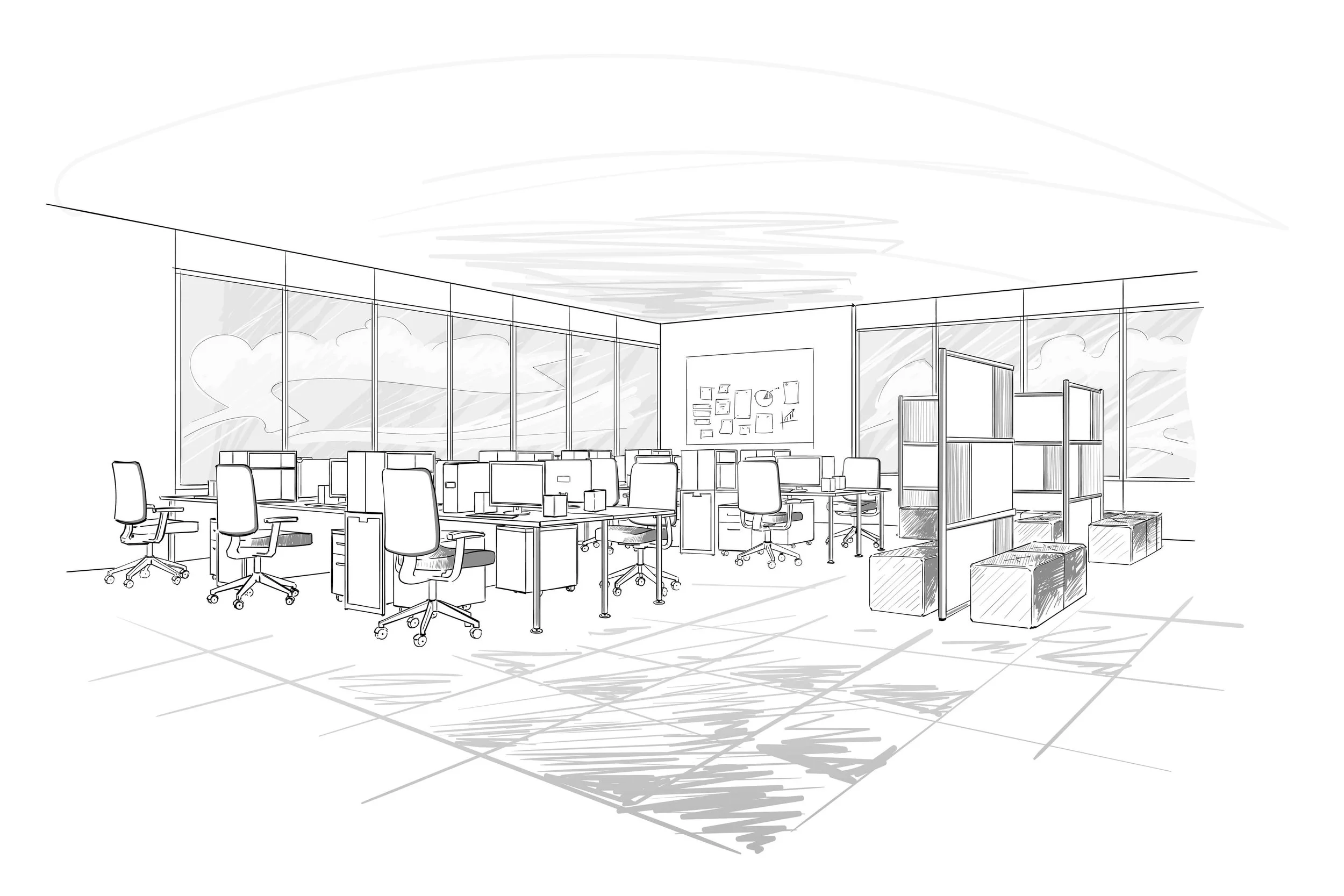For centuries, architects have masterfully manipulated tangible building materials. They have sculpted spaces with stone, glass, and steel, creating environments that inspire awe and serve a clear function.
However, there is a powerful, unseen material that is often treated as an afterthought, one that shapes how we experience a building on a profound, subconscious level. That material is sound. When used with intention, it can define the comfort, purpose, and even the health of a space. When ignored, however, it can lead to unforeseen negative consequences.
An acoustic failure in an expensive fitout project can result in devastating setbacks. Poor acoustic design can prove to be a critical liability, undermining a project's long-term viability, disrupting a client's business, and exposing an architectural firm to significant reputational risk.
Proactive acoustic design is not a luxury add-on, but a fundamental part of professional excellence, a strategic form of risk mitigation that protects your design integrity and your client's investment.
The question is, how do you move from simply acknowledging acoustics to integrating it as a core pillar of your design philosophy from day one? It starts with a foundational understanding of the principles and moves toward a holistic, creative approach. Here are five things every architect should consider when designing for sound.
1. The power of geometry and layout
A room’s fundamental geometry is its primary acoustic determinant. The simple shape of a room can lead to persistent problems like “flutter echo,” where sound bounces back and forth between two parallel, hard surfaces, or “standing waves” that create a distorted soundstage.
To find the right solutions, one can look to the past. Ancient Greek amphitheatres and Roman basilicas were meticulously designed with non-parallel, curved surfaces to naturally amplify and diffuse voices without any modern technology. Today's architects can leverage this knowledge to their advantage. Designing walls that are non-parallel or angled prevents sound from traveling in a predictable, back-and-forth path. Similarly, incorporating curved walls or other irregular surfaces can scatter sound waves evenly throughout a space, avoiding the focused echoes that muddy speech.
2. Understanding sound attenuation vs absorption
Every material you specify has a voice, or rather, a unique way it interacts with sound. To master this interaction, you must first understand the two core metrics that govern it: sound attenuation and sound absorption. While they sound similar, they serve entirely different purposes and confusing them is a common professional pitfall.
Sound attenuation: The sound barrier
Think of sound attenuation as a measure of a material's ability to block sound from traveling through it. Higher sound attenuation indicates better soundproofing performance. This metric is crucial for achieving speech privacy and preventing unwanted noise from bleeding from one space to another. It is the key to creating a quiet hotel room separated from the loud conversation next door or a confidential meeting room that ensures privacy.
Sound absorption: The sound sponge
In contrast, sound absorption measures a material's ability to absorb sound within a space. A high sound absorption rating is essential for controlling echo and reverberation, which improves speech clarity and overall acoustic comfort within a room. This is the solution for a large, open office where loud chatter creates a distracting din or an auditorium where a speaker's voice becomes muffled by echoes. Materials that achieve high sound absorption ratings are typically porous and soft, such as acoustic panels made from mineral wool or foam, upholstered furniture, and thick carpeting.
The critical mistake many make is assuming a material with high sound absorption will also have high sound attenuation. An acoustic foam panel may be an excellent sound absorber, but it will do little to block sound from traveling between rooms. The true art of acoustic design lies in using these materials in concert, selecting high sound attenuation materials to block sound, and high sound absorption materials to absorb sound and refine the acoustic character of a space.
3. Controlling the unseen
Even the most thoughtfully designed space can be ruined by an insidious source of noise – the building itself. A building's own mechanical and plumbing systems can create persistent, distracting noise that can undermine comfort and productivity.
These issues often arise from sources like fans, motors, and turbulent airflow within HVAC ducts. Plumbing systems can produce loud noises from water velocity, pressure fluctuations, and the familiar, jarring sound of "water hammer".
The most effective solutions for these problems are preventative, implemented during the design phase by specifying quieter equipment from the start, such as low-noise fans, variable-speed motors, and pumps with low noise ratings.
Once the quietest equipment is selected, the next step is to address the transmission of sound. Equipment noise is not just airborne; it travels as vibrations through the building's own structure. Transmission prevention can be achieved by decoupling equipment from the building using spring mounts, resilient hangers, and flexible connectors, creating a physical break that stops vibrations from traveling through the floor, walls, and ceiling.
These proactive measures may seem minor on a blueprint, but they have an outsized impact on the final product. The most elegant and financially sound solutions are often the simplest ones, made during the conceptual design phase.
4. Creating purposeful acoustic landscapes
The open-plan office has become a staple of modern design, yet it presents a paradox: the pursuit of collaboration can come at the expense of quiet, focused work and personal privacy. Architects are tasked with the challenge of designing spaces that can accommodate both needs simultaneously. The solution is not to rebuild cubicles, but to engage in a strategy known as acoustic zoning.
Acoustic zoning is the deliberate design of distinct areas within a larger space, each with a different acoustic profile that supports its intended use. This approach moves the conversation from simply reducing noise to thoughtfully shaping the user experience. You can create purposeful acoustic landscapes with a combination of architectural features and integrated furnishings.
For instance, flexible, mobile acoustic screens can be used to create semi-private spaces for individual work or small meetings without the permanence of fixed walls. Acoustics is also often integrated into the furniture itself. Modern acoustic furniture, like upholstered chairs and sofas, absorb sound and provide a sense of personal space. Self-contained "pods" or booths also offer a nearly soundproof sanctuary for confidential calls or heads-down work within a bustling office.
Acoustics is part of a larger, holistic design strategy that uses visual and behavioural cues to guide users. Simple changes in flooring, such as moving from hardwood to carpet in a quiet zone, can both absorb sound and signal a shift in the space’s purpose. Visual cues, like large potted plants or living walls, can provide sound absorption while also creating a sense of separation and biophilic comfort.
5. Blending form, function, and finance
Ultimately, the goal of acoustic design is to be invisible, a natural extension of the building's form and function. This requires architects to abandon the notion that acoustic solutions are separate, unattractive additions to a space. Modern acoustic products, from custom art panels to stylish ceiling baffles, can be beautiful and can enhance a space's visual identity, providing new textures, colours, and forms to work with.
The decision to prioritise acoustics early is not just about aesthetics or comfort; it is a strategic business decision. By integrating acoustics from the design phase, you are making a powerful value-add argument to your clients.
Elevate your practice with acoustic excellence
An architect's role is to be a custodian of the human experience within the built environment. Good acoustic design is not a luxury; it is a necessity for creating spaces that promote health, productivity, and enjoyment. By demonstrating a deep understanding of sound and partnering with acoustic experts who can bring that knowledge to life, you can elevate your practice and deliver a superior product that will stand the test of time.

